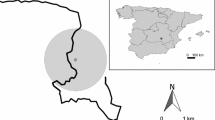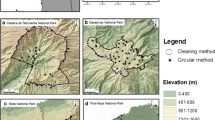Abstract
The Wild rabbit (Oryctolagus cuniculus) is an endemic species of the Iberian Peninsula and is essential for the conservation of endangered predators. Rabbits are also of high importance as a hunting species. From 1988, rabbits suffered the severe effects of rabbit hemorrhagic disease, which caused large declines in most populations. Despite this fact, the National Red Data Lists continued to classify rabbits as a “Least Concern” species. We used available hunting bag data from 1973 to 2002 to model national trends of rabbit abundance and to evaluate the conservation status according to the criteria of the National Red Data List and the World Conservation Union (IUCN). Generalized Additive Models were used as the statistical framework. The rabbit population of Spain suffered a large decline of about 71% between 1973 and 1993. This decline was 49% in the period 1980–1990. Based on both Spanish and World Conservation Union criteria, rabbits should be listed as ‘Vulnerable’, which demands a Conservation Plan Program. We suggest that the lack of concordance between the best available evidence and the conservation status of the species is a consequence of sociological constraints in conservation decisions. Rabbit conservation could face strong opposition from important socio-economic lobby groups (hunters and farmers). As such, governments and researchers may prefer to exclude rabbits from any status category requiring conservation action, despite the evidence of decline. We call for the urgent development of a nation-wide conservation program for rabbits which includes both socioeconomic constraints and the available biological data on population trends.
Similar content being viewed by others
References
Angulo E, Villafuerte R (2003) Modelling hunting strategies for the conservation of wild rabbit populations. Biol Conserv 115:291–301
Argüello JL, Llanos A, Pérez LI (1988) Enfermedad hemorrágica del conejo en España. Med Vet 5:645–650
Baines D, Hudson PJ (1995) The decline of black grouse in Scotland and northern England. Bird Study 42:122–131
Bandara R, Tisdell C (2003) Comparison of rural and urban attitudes to the conservation of Asian elephants in Sri Lanka: empirical evidence. Biol Conserv 110:327–342
Bangs EE, Fritts SH, Fontaine JA, Smith DW, Murphy KH, Mack CM, Niemeyer CC (1998) Status of the grey wolf restoration in Montana, Idaho, and Wyoming. Wild Soc Bull 26:785–798
Barker RJ, Sauer JR (1992) Modeling population change from time series data. In: McCullogh DR, Barrett R (eds) Widlife 2001: populations. Elsevier, New York USA, pp 182–194
Bernabeu RL (2000) Evaluación económica de la caza en Castilla-La Mancha. PhD Thesis, Universidad de Castilla-La Mancha, Spain
Blanco JC, González JL (1992) Libro Rojo de los Vertebrados de España. ICONA, Colección Técnica, Madrid, Spain
Blanco JC, Villafuerte R (1993) Factores ecológicos que influyen sobre las poblaciones de conejo. Efectos de la enfermedad hemorrágico vírica. TRAGSA, Madrid Spain
Bostford LW, Methot RD Jr, Johnston WE (1983) Effort dynamics of the northern California Dungeness crab (Cancer magister) fishery. Can J Fish Aquat Sci 40:337–346
Buckland ST (1984) Monte Carlo confidence intervals. Biometrics 40:811–817
Calvete C, Estrada R (2004) Short-term survival and dispersal of translocated European wild rabbits. Improving the release protocol. Biol Conserv 120:507–516
Calvete C, Estrada R, Villafuerte R, Lucientes J, Osácar JJ (2002) Epidemiology of viral hemorrhagic disease (VHD) and myxomatosis in the wild rabbit (Oryctolagus cuniculus) in the mid-Ebro valley, Spain. Vet Record 150:776–782
Calvete C, Angulo A, Estrada R (2005) Conservation of European wild rabbit populations when hunting is age and sex selective. Biol Conserv 121:623–634
Cattadori IM, Hudson PJ (1999) Temporal dynamics of grouse populations at the southern edge of their distribution. Ecography 22:374–384
Cattadori IM, Haydon DT, Thirgood SJ, Hudson PJ (2003) Are indirect measures of abundance a useful index of population density? The case of red grouse harvesting. Oikos 100:439–446
Cooke BD (2002) Rabbit haemorrhagic disease: field epidemiology and the management of wild rabbit populations. Revue Scientifique et Technique de l’Office International d’Epizooties 21:347–358
Delibes M, Hiraldo F (1981) The rabbit as prey in the Iberian Mediterranean ecosystems. In: Myers K, MacInnes CD (eds) Proceedings of the old world lagomorph conference. University of Guelph, Ontario Canada, pp 614–622
Droege S, Sauer JR (1990) North American Breeding Bird Survey annual summary 1989. U.S. Fish and Wildlife Service Biological Report 90:1–22
Drollette D (1996) Australia fends off critic plan to eradicate rabbits. Science 272:191–192
Ferrer M, Negro JJ (2004) The near extinction of two large European predators: super specialists pay a price. Conserv Biol 18:344–349
Fewster RM, Buckland ST, Siriwardena GM, Baillie SR, Wilson JD (2000) Analysis of population trends for farmland birds using generalized additive models. Ecology 81:1970–1984
Geissler PH, Sauer JR (1990) Topics in route-regression analysis. In: Sauer JR, Droege S (eds) Survey designs and statistical methods for the estimation of avian population trends. U.S. Fish and Wildlife Service Biological Report 90(1), pp 54–57
Gilpin ME (1973) Do hares eat lynx? Am Nat 107:727–730
Hastie TJ, Tibshirani RJ (1990) Generalized additive models. Chapman and Hall, London, United Kingdom
Henzell RP, Cunningham RB, Neave HM (2002) Factors affecting the survival of Australian wild rabbits exposed to rabbit haemorrhagic disease. Wil Res 29:523–542
Hilborn R, Walters CJ (1992) Quantitative fisheries stock assessment: choice, dynamics and uncertainty. Chapman and Hall, London, United Kingdom
IUCN (2001) IUCN red list categories and criteria: version 3.1. IUCN Species Survival Commission. IUCN, Gland, Switzerland and Cambridge, United Kingdom
James FC, McCullogh CE, Wiedenfeld DA (1996) New approaches to the analysis of population trends in land birds. Ecology 77:13–27
Kellert SR (1985) Social and perceptual factors in endangered species management. J Wild Manage 49:528–536
Kitson JC (2004) Harvest rate of sooty shearwaters (Puffinus griseus) by Rakiura Maori: a potential tool to monitor population trends? Wild Res 31:319–325
Lande R (1993) Risks of population extinction from demographic and environmental stochasticity, and random catastrophes. Am Nat 142:911–927
MacNab J (1983) Wildlife management as scientific experimentation. Wild Soc Bull 11:397–401
Mathsoft Inc. (1999) S-Plus 2000 for Windows. Seattle, Whasington, USA
MIMAM. (1999) Estrategia para la conservación del Lince Ibérico (Lynx pardinus). Ministerio de Medio Ambiente Comisión, Nacional de Protección de la Naturaleza, Madrid, Spain
MIMAM (2001) Estrategia para la conservación del Águila Imperial Ibérica (Aquila adalberti). Ministerio de Medio Ambiente Comisión, Nacional de Protección de la Naturaleza, Madrid, Spain
Monnerot M, Vigne JD, Biju-Duval C, Casane D, Callou C, Hardy C, Mougel F, Soriguer RC, Dennebouy N, Mounolou JC (1994) Rabbit and man: genetic and historic approach. Gen Select Evol 26:167–182
Muñoz G (1960) Anverso y reverso de la mixomatosis. Dirección General de Montes, Caza y Pesca Fluvial, Madrid, Spain
Neave HM (1999) Rabbit calicivirus disease program, report 1: overview of effects on Australian wild rabbit populations and implications for agriculture and biodiversity. Rabbit Calicivirus Disease Monitoring and Surveillance Program and Epidemiology Research, Program Bureau of Rural Sciences, Canberra, Australia
Parma AM, the NCEAS Working Group on Population Management (1998) What can adaptive management do for our fish, forests, food, and biodiversity? Integrat Biol 1:16–26
Peiró V, Seva E (1991) Maladie hémorrhagique virale du lapin de garenne au sud-est de l’Espagne. In: Proceedings XXth Congress of International Union of Game Biologists. Godollo, Hungary, pp 752–758
Potts GR, Tapper SC, Hudson PJ (1984) Population fluctuations in red grouse. Analysis of bag records and a simulation. J Anim Ecol 53:21–36
Pullin AS, Knight TM (2001) Effectiveness in conservation practice: pointers from medicine and public health. Conserv Biol 15:50–54
Reed DH, O’Grady JJ, Ballou JD, Frankham R (2003) The frequency and severity of catastrophic die-offs in vertebrates. Anim Conserv 6:109–114
REGHAB (2002) Reconciling gamebird hunting and biodiversity. V Forework Program of the European Union. Proposal number: EKV-2000-00637, Geneva, Switzerland.
Royama T (1992) Analytical population dynamics. Chapman and Hall, London
Siriwardena GM, Baillie SR, Buckland ST, Fewster RM, Marchant JH, Wilson JD (1998) Trends in the abundance of farmland birds: a quantitative comparison of smoothed Common Birds Census indices. J Appl Ecol 35:24–43
Thomas L, Martin K (1996) The importance of analysis method for Breeding Bird Survey population trend estimates. Conserv Biol 10:479–490
Thompson HV, King CM (1989) The European rabbit. The history and biology of a successful colonizer. Oxford University Press, Oxford, United Kingdom
Villafuerte R, Calvete C, Gortázar C, Moreno S (1994) First epizootic of rabbit hemorrhagic disease in free living populations of Oryctolagus cuniculus at Doñana National Park, Spain. J Wild Dis 30:176–179
Villafuerte R, Calvete C, Blanco JC, Lucientes J (1995) Incidence of viral hemorraghic disease in wild rabbit populations in Spain. Mammalia 59:651–659
Wilson MA (1997) The wolf in yellowstone: science, symbol, or politics? Deconstructing the conflict between environmentalism and wise use. Soc Natural Resour 10:453–468
Acknowledgements
We thank to Javier Seoane for his help with S-Plus software and Rachel Fewster for her support with the GAM code for analyzing population trends.
Author information
Authors and Affiliations
Corresponding author
Rights and permissions
About this article
Cite this article
Virgós, E., Cabezas-Díaz, S. & Lozano, J. Is the wild rabbit (Oryctolagus cuniculus) a threatened species in spain? Sociological constraints in the conservation of species. Biodivers Conserv 16, 3489–3504 (2007). https://doi.org/10.1007/s10531-006-9054-5
Received:
Accepted:
Published:
Issue Date:
DOI: https://doi.org/10.1007/s10531-006-9054-5




